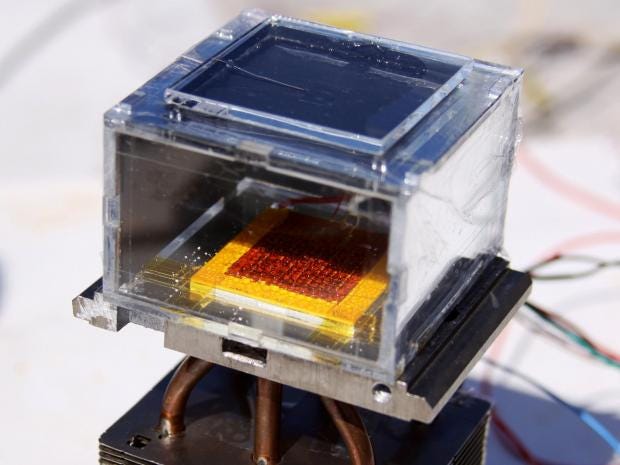New solar-powered device can create water out of thin air, even in deserts
'If you are cut off somewhere in the desert, you could survive because of this device'
- Ian Johnston Science Correspondent
- @montaukian
- 0 comments
|
|
|
|
Click to follow
The Independent Online
The Independent Online

A device that can create water out of thin air in even arid environments has been invented that could make Coleridge’s famous line “Water, water, everywhere, Nor any drop to drink” a thing of the past.
Using only the power of the sun and a special material with some extraordinary properties, the device is capable of producing 2.8 litres of water in 12 hours.
And it can work in conditions where humidity is as low as 20 percent.
Professor Omar Yaghi, who helped create the prototype water harvester, said: “We wanted to demonstrate that if you are cut off somewhere in the desert, you could survive because of this device.
READ MORE
“A person needs about a [330ml] can of water per day. That is something one could collect in less than an hour with this system.
“This is a major breakthrough in the long-standing challenge of harvesting water from the air at low humidity.
“There is no other way to do that right now, except by using extra energy. Your electric dehumidifier at home ‘produces’ very expensive water.”
But, as well as saving people stranded in a desert, the harvester could become a major part of everyday life, enabling people to have water without a connection to the public supply or a well.
“One vision for the future is to have water off-grid, where you have a device at home running on ambient solar for delivering water that satisfies the needs of a household,” said Professor Yaghi, a chemist at University of California, Berkeley.
“To me, that will be made possible because of this experiment. I call it personalized water.”
Science news in pictures
The device, described in a paper in the journal Science, uses a type of metal-organic framework, or MOF, which Professor Yaghi invented 20 years ago.
These combine metals like aluminium or magnesium with organic molecules. Since their invention, more than 20,000 different kinds of MOF have been created, each with different properties.
Some can capture carbon dioxide from chimneys, while others can separate out different types of oil in processing plants.
The water harvester uses zirconium and adipic acid, which binds water vapour.
Professor Yaghi teamed up with Professor Evelyn Wang, an engineer at the Massachusetts Institute of Technology, to create an effective device with help from colleagues.
The resulting harvester uses MOF crystals compressed between a solar absorber and a condenser plate.
As air passes through the porous MOF, water molecules attach themselves to the interior. Sunlight heats up the MOF and this drives the water molecules towards the condenser, where it is turned into liquid water.
“This work offers a new way to harvest water from air that does not require high relative humidity conditions and is much more energy efficient than other existing technologies,” Professor Wang said.
The current prototype can only absorb about 20 percent of its weight in water, but it is thought using other MOF types could boost this to more than double that.




No comments:
Post a Comment